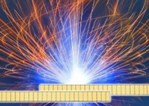High-Performance, High-Efficiency Laser Bars From OSRAM Opto Semiconductors


Santa Clara, CA - As part of its "BRILASI" research project, OSRAM Opto Semiconductors has improved the performance parameters of laser bars (laser chips) – their efficiency, output power, lifetime and beam quality – optimizing the overall product for premium performance. The results include laser chips with a wavelength of 910 to 980 nm that achieve an optical output of 120 W under real-world conditions and a typical efficiency of 70%.
"With this latest generation of laser bars we will be able to offer much more powerful components," said Ellen Sizemore, Director, LED/IR Marketing OSRAM Opto Semiconductors, Inc. All manufacturers of diode lasers can benefit because OSRAM has been long established as an independent supplier of laser chips and laser bars.
The semiconductor specialist will launch this high-performance initiative with laser bars that have a 50% fill factor. (The fill factor of a bar defines the ratio of active width to overall width.) The main applications for these laser bars include pumping of solid-state lasers and direct material processing. In addition to laser bars with a wavelength of 910 to 980 nm that achieve an efficiency of 70% at 120 W, OSRAM will produce laser bars with wavelengths of 808 nm and 880 nm which will deliver an efficiency of 62% at 120 W.
Structures with a fill factor of 20% that are ideal for optical fiber coupling applications complete the range of new more powerful components. OSRAM initially expects to produce 20% fill factor laser bars in the 910 to 980 nm wavelength range with a recommended output of 80 W.
A platform for new applications
With the new, more powerful laser bars, system output can be increased and still deliver the same lifetime. Additionally, systems can be made smaller and more reliable, without compromising output.
Samples of the new unmounted laser bars are currently available. The product launch for standard industrial laser bars with a 50% fill factor is planned for summer 2008; structures for optical fiber coupling applications will be launched in fall 2008.
About the BRILASI Research Project
The "BRILASI" research project (Brilliant High-Power Laser Diodes for Industrial Applications, FKZ 13N8601) was initiated by the Germany Ministry for Education and Research and executed by the VDI (Association of German Engineers); OSRAM served as the project coordinator. The project team was comprised of various partners from the laser system and end user sectors, as well as representatives from research institutes. The aim of the project was to develop highly efficient and reliable diode lasers for industrial applications. OSRAM has achieved the objective of this research project with laser bars that can be used at 100 to 170 W in a 20,000 hour continuous wave (CW) or long-pulse mode – depending on the emission wavelength and mounting technology. The key to this success was the optimization of the epitaxial structures, particularly with regard to reducing electrical losses to a minimum. Researchers found that it was possible to reduce the electrical series resistances without increasing the optical absorption losses, while at the same time improving the laser resonator.
For more information, please contact OSRAM Opto Semiconductors at www.osram-os.com.
SOURCE: OSRAM Opto Semiconductors
